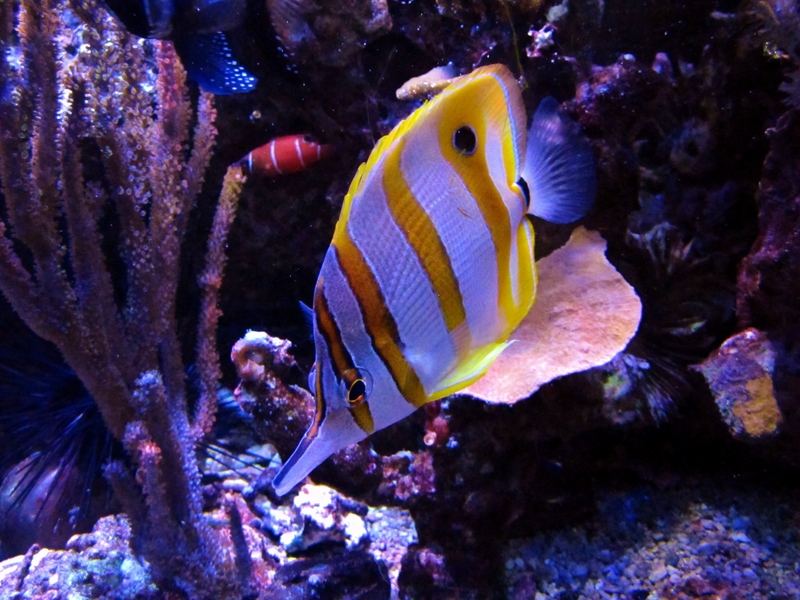- Joined
- Nov 8, 2015
- Messages
- 825
- Reaction score
- 449
Copperbands are notorious as a difficult fish to keep. They often come in skinny and refuse to eat prepared foods leading to their demise.
I would like to detail how I was successful with my copperband and hope to spread the knowledge.
Here is a link to my copperband butterfly story: https://www.reef2reef.com/threads/james-copperband-butterfly-log.475736/
First of all, you need a qt ready. 20 gallons would do; I used my old biocube 29. Preferably it would be bare bottom with a piece of live rock full of small animals and pods for the butterfly to peck on while you wean him into frozen food. If available, adding chaeto will help too. This means the qt is cycled so there will be no ammonia build up and the nutrients from he fish would be quickly used up by the chaeto, reducing work and stress. The salinity should also be the same as the lfs so all you have to do is float and release.
Now, to the fish. Look for a healthy fish with no disease or deformities. If the fish is eating in the lfs, that's even better. But the bare minimum is disease free. The disease and the stress that comes with treating it will kill the fish much faster than starvation will.
After adding him to the qt he will most likely peck on the rock. This will give you time to try new foods with him. Try live foods first like brine, blackworms, and clam. Hopefully he will like one of these three. At the same time get a small piece of rock that has a hole in it and stuff it with frozen mysis, brine shrimp, and what ever frozen food you have and freeze it. The next day, drop it in the tank. It will thaw and perhaps the butterfly will peck on it mimicking its natural behavior. After it starts accepting a type of food, slowly mix in other types.
Now, this is where finding a disease free fish comes into play. It may take days or weeks until the butterfly eat something and treating him for a disease will most likely kill the small pods in the rock and eliminate any chance of him eating frozen.
After he accepts frozen and is eating regularly, I would treat with prazi for 2 weeks and feed food soaked in metro. This will kill any internal parasites that may inhibit his weight gain. Then treat for any disease that may show up.
During this time, top off your water with saltwater to match your dt salinity. When adding him to the dt, an acclimation box is recommended so the existing fish get used to the butterfly.
Good Luck to you all and Happy Reefing!
I would like to detail how I was successful with my copperband and hope to spread the knowledge.
Here is a link to my copperband butterfly story: https://www.reef2reef.com/threads/james-copperband-butterfly-log.475736/
First of all, you need a qt ready. 20 gallons would do; I used my old biocube 29. Preferably it would be bare bottom with a piece of live rock full of small animals and pods for the butterfly to peck on while you wean him into frozen food. If available, adding chaeto will help too. This means the qt is cycled so there will be no ammonia build up and the nutrients from he fish would be quickly used up by the chaeto, reducing work and stress. The salinity should also be the same as the lfs so all you have to do is float and release.
Now, to the fish. Look for a healthy fish with no disease or deformities. If the fish is eating in the lfs, that's even better. But the bare minimum is disease free. The disease and the stress that comes with treating it will kill the fish much faster than starvation will.
After adding him to the qt he will most likely peck on the rock. This will give you time to try new foods with him. Try live foods first like brine, blackworms, and clam. Hopefully he will like one of these three. At the same time get a small piece of rock that has a hole in it and stuff it with frozen mysis, brine shrimp, and what ever frozen food you have and freeze it. The next day, drop it in the tank. It will thaw and perhaps the butterfly will peck on it mimicking its natural behavior. After it starts accepting a type of food, slowly mix in other types.
Now, this is where finding a disease free fish comes into play. It may take days or weeks until the butterfly eat something and treating him for a disease will most likely kill the small pods in the rock and eliminate any chance of him eating frozen.
After he accepts frozen and is eating regularly, I would treat with prazi for 2 weeks and feed food soaked in metro. This will kill any internal parasites that may inhibit his weight gain. Then treat for any disease that may show up.
During this time, top off your water with saltwater to match your dt salinity. When adding him to the dt, an acclimation box is recommended so the existing fish get used to the butterfly.
Good Luck to you all and Happy Reefing!
Last edited:



















